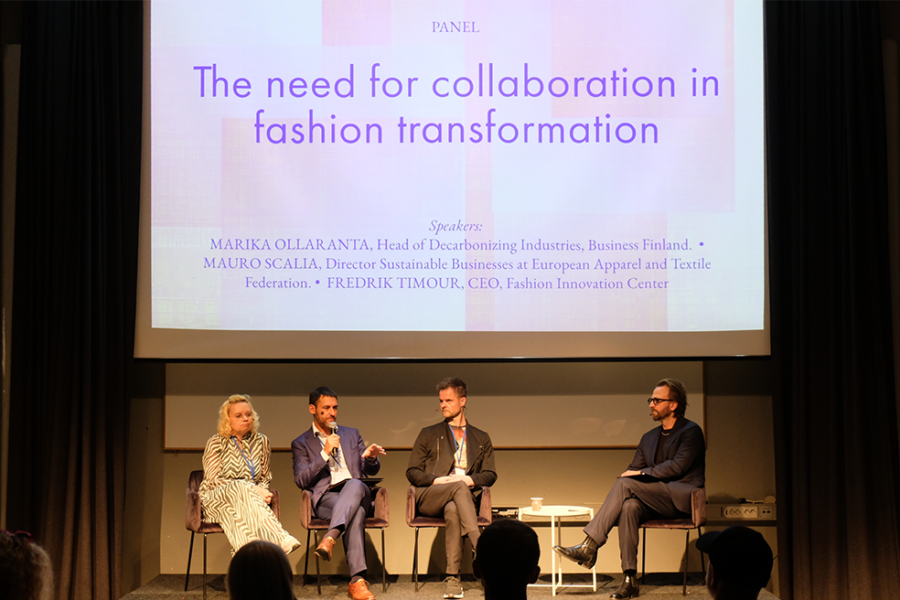
The expert on the latest development on the coming EU legislation and Textile Strategy
We speak to Mauro Scalia, Director of Sustainable Businesses at Euratex, on what’s cooking in Brussels – and the coming election that might change everything.
At the end of August, we welcomed the Transformation Conference to Stockholm Fashion District for half a day of insights into several of the most urgent industry topics. First out entering the stage, setting the tone for the day, was Mauro Scalia from Euratex (The European Apparel and Textile Confederation). The organisation works to achieve a favourable environment within the European Union for design, development, manufacture, and marketing of textile and clothing, and Marco shared the latest development in Brussels on the coming EU legislation and Textile Strategy.
– I focused on the mandatory part of the strategy – not only the vision which is now being pushed but also the concrete legal obligation which will come out of it, he told us afterwards. This will be done through at least 16 pieces of legislation, legally binding acts. On stage, I touched upon how the legislation will influence the choice of products with the so-called ’green claims’ (The Green Claims Directive proposal, a part of the third package of proposals on circular economy, made as part of the European Green Deal, Ed’s note) and the collection, sorting, and recycling of textile waste.
Can you share the time frame here? What can we expect throughout the fall?
– It’s difficult to answer exactly. We know that this European Commission will complete its current mandate by the summer of next year, so the clock is ticking now that it’s less than a year to complete. For the most important part of the legislation, for instance, the ’Eco-design’, we can imagine the final parts to be done in one year from now. It’s also possible that we’re going to have similar things also for specific products – a list of what will be the design parameters for products. In this case, we can imagine that the full effect on the market will happen about three years from now. If, however, they do not complete the negotiation on all the details, this might be postponed to the next Commission. When it comes to other of the most important parts, taking place in three years, we might see an impact in the market soon. Even if the legislation will give sufficient time to the supply chain to adapt, we can imagine that as soon as the main criteria to define things like durability or recycled contents are decided, the supply chain will start to move. This is especially true for big brands.
— The key question is when this will be known and written in black and white, similar to when the key requirements for a Digital Product Passport will be engraved in stone. When this is done, the so-called Delegated Acts (non-legislative acts adopted by the European Commission that serve to amend or supplement the non-essential elements of the legislation), especially the big brands will move. All this is available to see – we have put our info box with all the details online and you can have access to the information through what Euratex publishes on LinkedIn. Also, interestingly, the mandatory collection of discarded textiles, the EPR (Extended Producer Responsibility) and its schemes to charge a fee to the producer, brands, and retailers, is confirmed as of now on 1st January 2025. This might have an impact already one year from now.
How can next summer’s election affect things?
— That’s a very good question. There will be a new European Parliament and the member states will propose a new Commission, a new chief of the Commission, and a new Commissioner for each of the ministries. They will put forward a program which the parliament has to approve. That means that if we’ll have a parliament very sensitive to sustainability topics, they will obviously have the expectation that the new Commission will carry The Green Deal points forward in all the legislation. If we have a parliament very much interested in the economic problem that the society have, with the inflation rate and rising living costs, they might make compromises in it. Or, they may be obliged to find a good solution to reconcile sustainability and economic challenges. At this point, we have no indication to anticipate a change of priorities, because climate change seems to be a priority to stay at the European level. But there could be a mitigation, adjustment, or compromises based on the societal challenges that we’re going to have.
If you were to pick one crucial thing that’s affecting the industry the most, what would you choose?
— The part concerning the Eco-design. That’s the only piece of legislation, as far as we know, that will set minimum criteria worldwide and that every player should conform to, to sell a product on the EU market. There will be performance requirements and information requirements and it’s, by far, the most advanced piece of legislation.
Which part of the value chain will be affected the most?
— All of it, Scalia explains. The brands will have to design the products to comply with those parameters and suppliers will have to satisfy these requirements. The price will be at stake and might change in some cases and we can also imagine that the more a product is already designed with certain sustainability criteria, the less it could be impacted. Because then, it would already be produced according to certain quality standards and not have to change dramatically. For other types of products, such as those made of low quality, we can imagine to see most of the challenges. Those products will have to change to be able to comply with the new norms.
As an industry player, what are the most crucial calls to action in order to be prepared?
— I can tell you what we are thinking about. First of all, we conciliate economic challenges with sustainability priorities. We want both. For us, it’s not about either growth, economic competitiveness, or sustainability. We need all. With that, we fulfil societal challenges across the board, to protect the environment, but also to ensure people have jobs and companies’ growth in fair conditions. We also hope that we will be able to increase the market for sustainable products, both inside the European Union and outside. Sustainability and environmental challenges are global and not just European. Currently, it’s only Europe which seems to put a lot of emphasis on its policy agenda, but this should – and is very likely also to – expand to other world regions.
Let’s hope.
— Yes. We want European businesses to also profit from this global interest in sustainability. And we also need to push forward many other points, such as low energy costs and access to skilled workers. In a nutshell, these are some of the points that we hope to put forward in the next years.
When you meet industry executives, what do you hear from them? Excitement? A lot of questions?
— It’s a combination, I would say, of excitement and worries. Considering the industry, there are many players which has already bet on sustainability for a very long time to differentiate from their competitors and valorise the higher cost. In that case, they see an opportunity because this transformation can grow their business. In other cases, they are much more concerned. Remember that we are in a moment where the energy prices are too high in Europe, much higher than in other world regions, and that is definitely impacting the production. We have several challenges linked to inflation. Therefore, investing in sustainability and paying for more sustainable and costly products, is not something that everybody can do. These are the concerns and it’s not blind excitement, but there is also a lot of expectation to see how the whole process will continue.
What’s the one thing to keep an eye on here?
— I would still stress the Eco-design part because in itself, as mentioned, it’s both elements of product characteristics, but also of data exchange with the Digital Product Passport which, in itself, is an enabler of many other sustainability activities and legislation. So, this is probably one of the most exciting and challenging aspects of our industry – and what everybody should be keeping an eye on.




